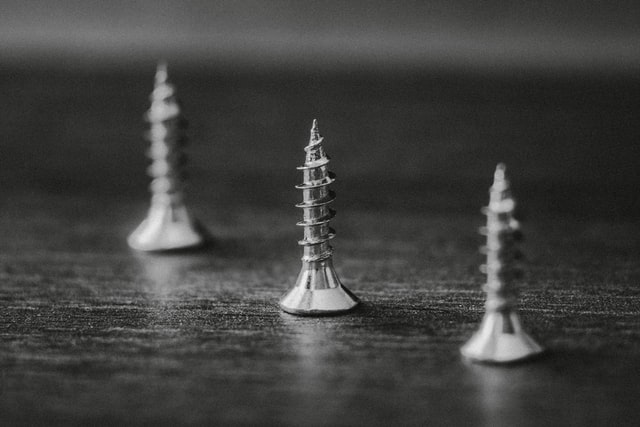How to remove a stripped screw
For any repair enthusiast, stripped screws are a nightmare. Some screws, no matter how hard you try, will not budge. Frustration sets in, and the once “+” shape transforms into a “O” before you realize it. We’ve got your back, don’t worry. This instruction will show you to remove the screw.
Remove a Stripped-Head Screw
A power screwdriver can tear away the cross shape in a Phillips head screw if you forget the pilot hole or drive a screw too quickly. The screw can’t be pushed any farther or backed out after that’s gone. For your project, you’ll need to figure out how to remove a stripped screw. If the screw head is visible above the wood surface, carefully spin it counterclockwise with a pair of locking pliers clamped on the screw as near to the wood as possible. To keep against cracking the skull, work slowly. Because locking grip pliers sometimes lose their hold, cut a tiny piece of cardboard in half and slide the notched halves over the screw to protect the wood surface beneath.
A slip will not become a scratch in this manner. If the stripped screw head is flush with the wood on #12 or larger screws (and you don’t want to risk damaging your project), use a screw extractor. First, drill a 1/8-inch deep hole in the screw head’s centre to receive the biggest screw extractor that will fit. In the beginning hole you drilled, put the extractor tip. Slowly turn the extractor to back the screw out of the wood far enough for the locking pliers to hold it and remove it.
Techniques:
- Screwdrivers of several types
- Rubber band number two
- Pliers to Extract Screws
- Superglue
To avoid harm from debris or sparks when using a rotary tool, always wear safety eyewear.
- Your screw is stripped, and your screwdriver isn’t cutting it any more. Consider the following before calling in the big guns:
- Various screwdrivers should be used. To test if you can get a flat head screwdriver to catch on a section of the stripped screw, try slightly smaller or bigger head sizes first.
- A rubber band can provide additional grip.
- Turn a screwdriver that is the right size into the hole.
- Use a pair of screw extraction pliers if the screw head is accessible. Turn the pliers, and the screw should turn with it if you have a strong hold!
- You can probably back out the screw the rest of the way with a screwdriver once it’s loosened a little.
- Use a pair of screw extraction pliers if the screw head is accessible. Turn the pliers, and the screw should turn with it if you have a strong hold!
- You can probably back out the screw the rest of the way with a screwdriver once it’s loosened a little.
- Use a pair of screw extraction pliers if the screw head is accessible. Turn the pliers, and the screw should turn with it if you have a strong hold!
- You can probably back out the screw the rest of the way with a screwdriver once it’s loosened a little.
- Use the rotary tool to make a tiny cut in the stripped screw, allowing you to remove it with a flathead screwdriver.
- The incision should be deep enough for a flathead screwdriver to fit through, yet thin enough for the screwdriver to grasp.
- Remove the stripped screw’s head and make a single thin cut.
- To remove the device’s screw, use a flathead screwdriver.
- The driver size will be determined by the screw size; nevertheless, choose the maximum size that will fit in your cut.
- If a screwdriver won’t fit into the cut, enlarge it with the rotary tool. Only make little cuts; if you remove too much of the screw, a screwdriver will not catch and you will be unable to spin it.
Taking out a screw with a broken head is a difficult task.
Simply drill a pilot hole and drive a second screw approximately 1/4 inch from the original one if the damaged screw can be left in place, such as when attaching a deck board. When you can’t adjust the screw placement by even 1/4 inch, like when installing a hinge, things get a little difficult. After you’ve fixed the damaged component, you’ll need to go back in and repair any damage you’ve caused.
When attempting to remove a damaged screw, one of three events will most likely occur:
- The screw shank extends past the wood surface, and the head snaps off. With locking pliers, grasp the screw shank and carefully move it counterclockwise until it comes loose.
- At the wood’s surface, the screw snaps. To acquire a firm grasp on the locking pliers and back out the screw, use the tip of a utility knife with a sharp blade to cut away just enough wood around the shank. Then, centred on the screw hole, drill a 1/2-inch-diameter hole. Fill the hole with a dowel (if the wood will be hidden) or a wood plug cut from matching stock for a smooth fit. Use a dowel topped with a plug to provide the replacement screw plenty of material to grab if aesthetics is important and the screw is longer than 1 inch.
- The screw breaks off more than an eighth of an inch beneath the surface. Now is a good moment to consider how important that fastener is in that particular spot. If yes, drill down to the broken end of the screw with your 1/2-inch bit. Make five or six starting holes around the screw by using the tip of a nail and gentle taps with a hammer.

